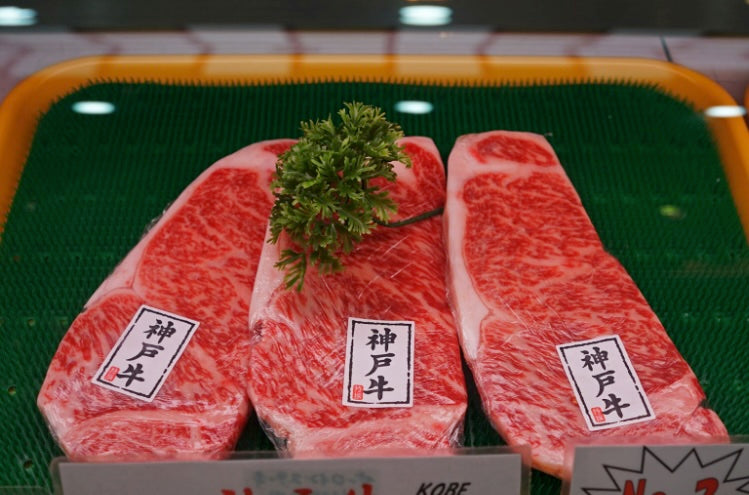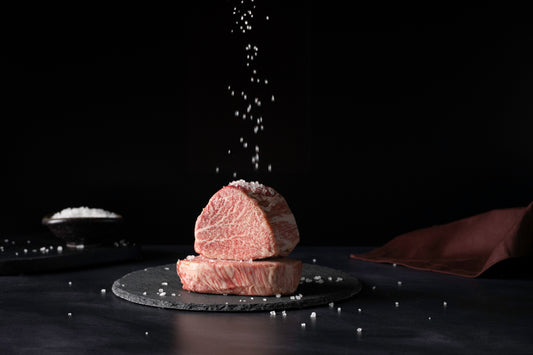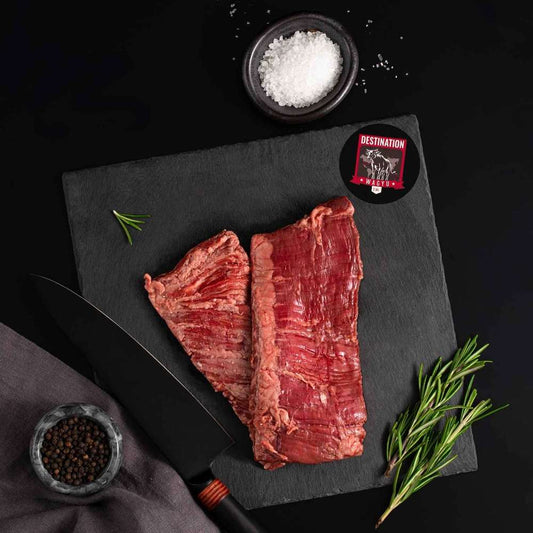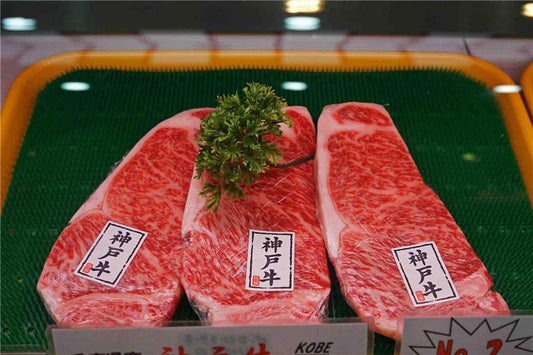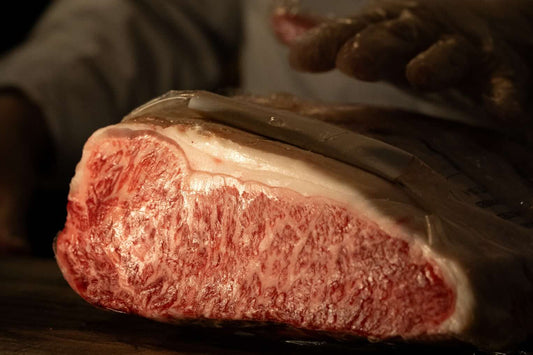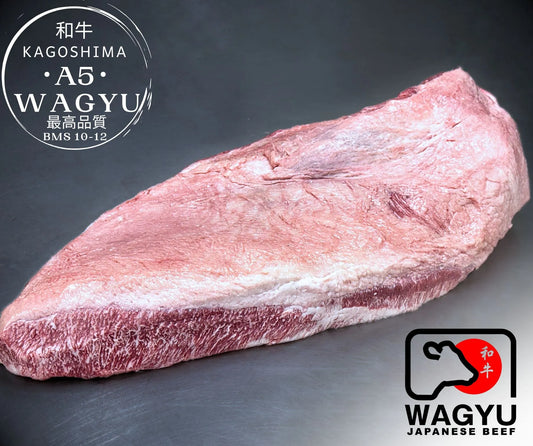-
Wagyu striploin features ultra-fine, evenly distributed marbling from breeds like Japanese Black, enhancing texture and fat melt.
-
The longissimus lumborum muscle delivers uniform cuts ideal for precise portioning, with flavor and tenderness driven by fat composition.
-
Grading systems like Japan’s BMS and Australia’s MB score correlate with fat quality and inform optimal cooking, sourcing, and pricing strategies.
As someone who has worked extensively with premium beef programs and culinary development, I’ve often found that the Wagyu strip steak is one of the most misunderstood cuts in the ultra-premium category. It’s a paradox. Familiar to most professionals in the West as a steakhouse staple, yet radically different in its sensory profile, fabrication, and handling when sourced from Wagyu cattle. This article is meant to go well beyond the basics and provide a thorough exploration of what makes Wagyu strip steak unique, how to approach it from a butchery and culinary standpoint, and how it compares to other high-end cuts. Whether you're managing a fine-dining kitchen, overseeing a meat program, or simply sharpening your mastery of beef, this guide is designed to offer practical, anatomical, and comparative insights rooted in science and craft.
Defining Wagyu in a Professional Context
Etymology and Legal Definitions
Wagyu, when translated literally, means “Japanese cow.” However, in a professional context, the term has much more precision and legal weight, particularly within Japan and its major trading partners. In Japan, the term is protected under agricultural and trade regulations. Only beef derived from four specific native breeds qualifies: Japanese Black, Japanese Brown, Japanese Polled, and Japanese Shorthorn. Outside of Japan, the term “Wagyu” is used more liberally. The United States and Australia, for example, allow crossbred cattle to be labeled as Wagyu under certain conditions, often requiring only 50 percent Wagyu genetics. This has led to a tiered market, with Fullblood, Purebred, and Crossbred Wagyu lines coexisting with vastly different eating qualities and production standards.
Understanding the legal definition is crucial for procurement. If you're sourcing for a fine-dining venue, an F1 cross (50 percent Wagyu, 50 percent Angus) might not yield the marbling or texture you're promising on the menu. Conversely, Fullblood Wagyu, particularly of Japanese origin, requires meticulous handling and pricing. When we talk about Wagyu strip steak, the breed origin significantly influences everything from fat composition to yield loss, so it’s imperative that we are aligned on nomenclature from the outset.
Breeds and Genetic Lines
Within the Wagyu category, the Japanese Black breed, or Kuroge Washu, is the gold standard for marbling. It possesses genetic markers that promote extreme intramuscular fat deposition, especially the SCD and UCP1 alleles that are associated with fine, evenly distributed marbling and low melting point fat. Bloodlines within Japanese Black are further categorized into Tajima, Kedaka, Fujiyoshi, and others, each with distinct growth rates and meat quality characteristics.
Tajima, the most well-known bloodline, is particularly suited for striploin fabrication. It produces smaller-framed animals with slower growth but higher BMS potential (Read more about BMS). In contrast, Kedaka lines yield larger carcasses with improved ribeye area but often slightly coarser marbling. These genetic differences are not just academic. They directly influence how the striploin behaves in aging, cooking, and portioning.
Crossbreeding and Lineage Classifications
International Wagyu production typically involves crossbreeding for yield, climate adaptability, and feed efficiency. In Australia, you'll encounter MB scores (Marble Score) ranging from 4 to 9+, which often come from F1 to F4 generations. F1 refers to 50 percent Wagyu, F2 to 75 percent, and so forth, with Fullblood representing 100 percent Japanese Wagyu lineage with traceable parentage.
Professionally, this is where menu language and internal labeling must be airtight. A strip steak from a high-marbling F1 may be visually impressive but will lack the mouthfeel and melting quality of a Fullblood or even high-percentage Purebred strip. When we benchmark quality, we must account for this genetic framework, especially when comparing across programs.
Striploin: Anatomical and Butchery-Based Definition
Primal and Sub-Primal Location
The striploin comes from the short loin primal, posterior to the rib primal and anterior to the sirloin. It encompasses the longissimus lumborum muscle, which continues from the ribeye but becomes more uniform and less complex as it extends along the spine. In Western butchery, it is typically separated between the 12th and 13th rib. In Japanese seam butchery, the separation may be more precise and customized depending on the desired end use.
The anatomical location is central to understanding the Wagyu strip steak’s behavior. This muscle does relatively little work, which is why it remains tender. However, unlike the ribeye, the striploin lacks the complex multi-muscle architecture. This results in more even cooking and consistent portioning but also means that the steak depends heavily on marbling and aging to deliver a comparable sensory experience.
Muscle Architecture
The longissimus lumborum is a single, large, and elongated muscle with a tight grain and low connective tissue content. It is bounded by a fat cap on the dorsal side and by a silverskin on the ventral side that must be removed for proper trimming. In Wagyu cattle, the marbling penetrates this muscle much more densely than in conventional breeds, forming fine striations that resemble lace rather than clusters.
For butchers, this uniformity is a blessing and a challenge. It allows for very consistent slicing and portioning, but the density of fat means extra care must be taken to manage knife friction and avoid melting during fabrication. For chefs, understanding this muscle’s grain and marbling pattern is key to optimizing slice orientation and thickness.
Anatomical Landmarks and Trim Considerations
Trimming the striploin in Wagyu demands more than a standard NAMP protocol. The fat cap is often thicker due to the high body condition score of Wagyu cattle. While this subcutaneous fat adds flavor and insulation during cooking, excessive amounts must be reduced for balanced plate presentation. Additionally, seam lines near the anterior end can expose minor muscles that must be trimmed or shaped for consistent texture.
Another consideration is the spinal edge, which often carries residual vertebral cartilage in bone-in versions. Removing this cleanly without damaging the muscle integrity takes experience and razor-sharp equipment. Understanding where the marbling converges within the steak also helps determine whether the end cuts are suitable for high-end service or better allocated to other preparations.
Wagyu Striploin Specifics: Distinctive Traits
Marbling Characteristics
Wagyu striploin exhibits marbling that is significantly finer and more evenly dispersed than in Angus, Hereford, or other Western breeds. The marbling tends to follow the muscle grain in thin, almost hair-like ribbons. This is in contrast to the chunkier marbling clusters in conventional breeds. The result is not just visual appeal but a completely different eating experience. The fat renders more uniformly and at lower temperatures, coating the palate with a silkiness that is unmatched.
The cross-sectional marbling pattern also varies along the striploin. The head end, closest to the ribeye, typically exhibits the most intense marbling. The tail end, near the sirloin, tends to have a tighter grain and slightly firmer texture. When portioning for service, I generally reserve the center-cut or anterior slices for à la carte and high-value tasting applications.
Texture, Grain, and Tenderness
Despite not being the most tender cut on the animal, the Wagyu striploin often registers a higher perceived tenderness than even tenderloin, due to the lubricating effect of the fat. This is why texture evaluation must go beyond Warner-Bratzler shear tests and incorporate sensory panels when designing menus or evaluating suppliers.
The fine muscle grain, minimal collagen, and low connective tissue allow the fat to do much of the work. During cooking, the fat renders internally, creating a pseudo-braising effect that delivers a soft, almost custard-like mouthfeel. However, this is contingent on proper cooking technique. Overcooking, even slightly, will push the fat past its ideal render point and lead to pooling or leakage, which negatively affects both texture and appearance.
Fat Composition
One of the hallmark features of Wagyu beef is its lipid profile. The fat in Wagyu contains significantly more monounsaturated fats, particularly oleic acid, than other breeds. This gives it a lower melting point, often cited around 77 degrees Fahrenheit, which is below human body temperature. As a result, the fat literally melts on the tongue, delivering a rich, savory experience without the waxiness sometimes found in grain-finished domestic beef.
This fat composition also affects storage, aging, and cooking behavior. It is more susceptible to oxidation, which requires careful handling in dry aging or extended cold storage. But when handled correctly, the fat enhances the Maillard reaction, amplifying flavor without the need for aggressive seasoning or compound butters.
Striploin Cut Variants and Fabrication Techniques
Whole Striploin (Bone-In and Boneless)
When dealing with a full Wagyu striploin, whether bone-in or boneless, the fabrication process is a key determinant of yield, consistency, and final product application. The whole muscle typically ranges from 12 to 16 pounds, though this can vary depending on the breed, feed duration, and carcass maturity. Japanese carcasses are generally broken down with an emphasis on muscle integrity and minimal oxidation, resulting in striploins that retain more subcutaneous fat and membrane structure. Western systems, especially those adhering to NAMP specifications, favor a more utility-oriented breakdown.
Bone-in striploins are uncommon in Wagyu exports but are occasionally encountered in specialty shipments or domestic Fullblood programs. When working bone-in, precise saw cuts are essential to avoid shattering the delicate fat seams near the chine bone. Boneless versions are more practical for portion control, and most culinary operations prefer these for ease of trimming, vacuum sealing, and aging.
Portioning Techniques
Once the whole striploin is cleaned and trimmed, the portioning strategy will depend on the intended use. For à la carte service, the standard is to fabricate 8 to 10 ounce steaks from the center cut, typically between the fifth and eighth steak in from the anterior end. These are the most symmetrical in shape and offer the best marbling consistency. The tail and head ends can be portioned into smaller steaks, saku blocks, or reserved for applications like yakiniku or tartare.
Cut thickness should take into account marbling intensity and cooking method. For example, a highly marbled A5 Wagyu strip should rarely exceed 0.75 inches in thickness. Thicker cuts risk overrendering the fat before the protein reaches target doneness. In contrast, an Australian MB6 or MB7 cut can be fabricated thicker because the fat content does not overpower the meat matrix. I prefer to weigh each portion precisely using a calibrated scale rather than relying on visual estimation, especially when dealing with cuts that cost several hundred dollars per loin.
Specialized Cuts
Beyond the standard steak, Wagyu striploin can be tailored into specialized portions depending on the format of the service. The strip filet, sometimes referred to as a strip center, offers the straightest grain and highest degree of marbling balance. It is ideal for Western fine dining where clean lines and center-of-plate aesthetics are critical. For Japanese applications such as kaiseki or teppanyaki, I often fabricate block-style cuts called saku blocks, typically 100 to 120 grams each, which allow for uniform searing and precise portioning.
Another approach involves fabricating the striploin into thin-sliced portions for shabu-shabu or sukiyaki. In this format, fat integrity and knife skills become paramount. The grain must be perpendicular to the cut surface to prevent tearing during cooking, and the slices must be refrigerated to near-freezing for clean, uniform shapes.
Culinary Science and Application of Wagyu Strip
Thermal Behavior of Wagyu Fat
Cooking Wagyu striploin requires an understanding of how its fat behaves under heat. The low melting point of Wagyu fat, typically below 80 degrees Fahrenheit, means it begins to liquefy with minimal thermal input. This is both an opportunity and a hazard. On one hand, the fat contributes to early flavor development through surface rendering and gentle internal lubrication. On the other hand, overexposure to direct heat can lead to rapid breakdown, fat loss, and texture collapse.
In my experience, the best results come from a two-stage approach: gentle initial cooking using sous-vide or low oven heat, followed by a quick, high-heat sear on a carbon steel or cast iron surface. This allows for even internal temperature development while preserving the fat’s integrity. Open flame or infrared broilers can be effective for Australian or American Wagyu striploins with moderate marbling, but they are too aggressive for Japanese A5 grades.
Optimal Cooking Techniques by Grade
For A5 Wagyu strip, I recommend techniques that minimize cook time and preserve fat structure. Teppanyaki or plancha-style cooking works extremely well. The steak should be brought to room temperature, sliced thinly, and seared for less than one minute per side. Finishing with a brush of rendered Wagyu tallow or light soy-based glaze can enhance both mouthfeel and umami without overpowering the natural flavor.
For MB6 to MB9 striploins, more traditional Western methods apply. Reverse searing, sous-vide finishing, or charcoal grilling with precise temperature zones can produce excellent results. I advise resting these steaks longer than normal to allow fat to reabsorb into the muscle matrix rather than pooling on the cutting board. Resting under a tented cover or in a warming drawer with gentle convection preserves the fat while keeping the crust intact.
Slicing and Resting Techniques
Resting is often misunderstood in the context of Wagyu. With high-marbling Wagyu strip steaks, the rest period is not just about juice redistribution; it’s also about fat stabilization. I recommend a rest period of at least five minutes for steaks under 8 ounces, and up to eight minutes for thicker cuts or block portions. Avoid tenting tightly with foil, which creates steam and softens the crust. A gentle ambient rest or a pass-through cabinet with controlled humidity is ideal.
When slicing, angle matters. Cutting on a slight bias across the grain maximizes fat exposure per bite and shortens fiber length, enhancing tenderness. This is particularly important when serving family-style or as part of a multi-course sequence, where visual presentation and eating texture are equally important.
Serving Methodologies
Serving Wagyu striploin requires restraint and balance. The richness of the fat and the umami intensity demand smaller portion sizes than standard beef. In most tasting menus, I cap portions at 2 to 3 ounces, sliced into three or four segments. Each piece is treated almost like a flavor course rather than a protein anchor.
Pairings should be chosen to cleanse and reset the palate. Classic accompaniments include wasabi, coarse salt, grated daikon with ponzu, or citrus-based relishes. Western garnishes such as pickled ramps, porcini dust, or veal jus reductions can also work, but they must not compete with the primary flavor of the Wagyu. Wines should be structured but not overly tannic. I lean toward aged Burgundy, high-acid Pinot Noir, or Champagne when building beverage pairings.
Grading Systems and Quality Assessment
Japanese JMGA Grading
The Japanese Meat Grading Association (JMGA) employs a dual-axis grading system that evaluates both yield and quality. Yield grades range from A to C, with A representing the highest muscle-to-carcass ratio. Quality grades range from 1 to 5, incorporating four criteria: marbling, color and brightness, firmness and texture, and fat color and quality.
The Beef Marbling Standard (BMS) scale further refines marbling assessment, ranging from 1 to 12. Wagyu striploin typically scores between BMS 8 and 12 for A5 grades, depending on the bloodline and feeding regimen. The striploin is often used as one of the three evaluation muscles alongside the ribeye and tenderloin, so its grading is critical for overall carcass classification.
Australian MSA and Wagyu Marble Scores
Australia utilizes the Meat Standards Australia (MSA) system in conjunction with a Wagyu Marble Score (MB) that ranges from 1 to 9+. While the scale is not directly equivalent to Japan’s BMS, an MB9+ roughly corresponds to BMS 10 to 12. The MSA system incorporates eating quality science based on factors like ossification, pH, and intramuscular fat, which adds predictive power for end use.
For striploin applications, MB6 to MB8 is often the sweet spot for versatility. It provides a balance of fat and yield that suits both Western and Japanese service models. MB9+ is more niche and typically reserved for fine dining where a smaller, highly indulgent portion is appropriate.
USDA System and Limitations
The USDA grading system is based on marbling visual assessment in the ribeye muscle at the 12th rib, along with carcass maturity. It does not directly address the striploin, nor does it accommodate the ultra-high marbling levels of Wagyu. As a result, Wagyu beef often gets lumped into the Prime category, even when it significantly exceeds Prime specifications.
This creates marketing challenges and also leads to overpromising in some cases. A USDA Prime label on a crossbred F1 striploin does not guarantee Wagyu-like fat behavior or flavor. Professionals must therefore rely on additional documentation, such as BMS, bloodline certifications, and vendor history, to make informed sourcing decisions.
Comparative Cut Analysis
Wagyu Strip vs. Ribeye
When comparing Wagyu strip steak to Wagyu ribeye, the differences are immediately evident both in structure and eating experience. The ribeye is a composite cut consisting of the longissimus dorsi, spinalis dorsi (the ribeye cap), and complex intermuscular fat structures. This makes the ribeye richer and more varied in texture, but also more inconsistent in portioning and cooking. In contrast, the strip is a single muscle, the longissimus lumborum, which delivers a more uniform texture and allows for precise, repeatable cooking results.
The marbling in the ribeye tends to concentrate around the eye and the cap, resulting in pockets of intense fat flavor followed by leaner bites. The striploin’s marbling, however, is distributed in finer, more even layers, especially in high BMS Wagyu. This produces a steadier flavor release and a more controlled fat melt, particularly suitable for fine dining service where predictability and presentation are critical. If I am designing a steak-centric menu with multiple cuts, the strip is often chosen for its balance, while the ribeye is reserved for occasions where richness and drama are desired.
Wagyu Strip vs. Tenderloin
The tenderloin, despite its unmatched tenderness, lacks the marbling and flavor depth of the Wagyu strip. This is even more apparent in Wagyu cattle, where the tenderloin may be softer but still does not carry the same oleogustus or umami complexity as the striploin. The muscle fiber in the tenderloin is extremely fine, with little connective tissue, making it ideal for delicate preparations. However, it does not benefit from the same degree of intramuscular fat, and that limits its application when marbling-driven flavor is the priority.
In practice, I use the tenderloin for precision dishes where tenderness is non-negotiable, such as tartare or sous-vide medallions. The strip, however, is better for searing, grilling, and higher-heat techniques because it can withstand more aggressive methods without sacrificing quality. This gives the Wagyu striploin a broader range of applications and a more versatile role on the plate.
Wagyu Strip vs. Sirloin Cap (Coulotte)
The sirloin cap, or coulotte, is another cut worth comparing. It comes from the biceps femoris muscle and is known for its triangular shape and robust beef flavor. In Wagyu cattle, the sirloin cap can carry exceptional marbling, especially in Tajima-line animals. However, the grain is longer, and the texture slightly more fibrous compared to the striploin. This makes it less suitable for traditional steak cuts but ideal for roasting or slicing thinly for yakiniku.
From a yield standpoint, the sirloin cap has more trim loss and is less consistent in shape. The strip, by contrast, is easier to portion uniformly and can be used across multiple formats without significant structural adjustments. If consistency and versatility are primary concerns, the striploin remains the better option. The sirloin cap, while flavorful and cost-effective, requires more skill in trimming and cooking to reach the same level of refinement.
Wagyu Strip vs. Chuck Flap (Zabuton)
The chuck flap, or zabuton, is a rising star in the Wagyu world, particularly in yakiniku and Korean BBQ formats. It comes from the shoulder clod and is known for its intense marbling and loose, almost brisket-like texture. In Wagyu cattle, zabuton can reach BMS levels comparable to striploin, but its structure is completely different. The grain is coarser, and the muscle fibers are more active, resulting in a more assertive chew and bold flavor.
While zabuton excels in thin-sliced grilling, it does not perform well as a thick steak due to its structural variability. It also has more intermuscular seams that can disrupt the eating experience if not trimmed correctly. The striploin, being more uniform and refined, is better suited for traditional steak applications and fine dining contexts. Both cuts have their place, but the Wagyu strip offers a more elegant, balanced experience suitable for high-end menus.
Dry Aging and Wet Aging Dynamics
Behavior of Wagyu Strip in Aging Chambers
Aging Wagyu striploin, particularly those with high BMS scores, requires a different approach than conventional beef. The fat content in Wagyu acts as both a protector and a liability during the aging process. On one hand, the dense marbling insulates the muscle and slows down oxidation. On the other hand, the high unsaturated fat content is more prone to rancidity if not carefully monitored. For dry aging, humidity control and airflow are critical. I use chambers with RH levels between 75 and 80 percent and monitor ammonia and mold development closely.
The striploin is more forgiving than the ribeye in aging due to its simpler muscle structure and lower connective tissue. A 30-day dry age can enhance its nutty and umami notes without introducing excessive funk. However, extending beyond 45 days requires expert trimming and flavor pairing to avoid overpowering the natural sweetness of Wagyu fat. Wet aging is more common in export programs and offers reliable tenderness improvements with minimal weight loss. It is ideal for operators focused on yield and cost control, though it lacks the flavor development of dry aging.
Yield Loss and Flavor Development
Dry aging inevitably leads to yield loss through dehydration and surface trimming. For high-value Wagyu striploin, this must be carefully calculated. In my experience, a 30-day dry-aged Wagyu strip can lose up to 15 percent of its weight in water and an additional 5 to 8 percent in trimming. While this may seem high, the flavor payoff can justify the cost in fine dining contexts. The key is to allocate aged cuts to specific dishes where the dry-aged profile enhances rather than dominates the dish.
Flavor development in aged Wagyu is different from conventional beef. The high oleic acid content tends to mellow rather than intensify, creating a rounder, less metallic flavor profile. Enzymatic activity during aging breaks down proteins into amino acids like glutamate and inosinate, which are responsible for umami. This synergizes beautifully with the marbled fat to create a deep, satisfying flavor that lingers without being overwhelming.
Sourcing, Authenticity and Market Dynamics
Exporting Countries and Regional Styles
Authentic Wagyu striploin can now be sourced from several countries, each with its own protocols and pedigree tracking systems. Japan remains the gold standard, with prefectures like Miyazaki, Kagoshima, and Shiga producing award-winning carcasses. Each region has slightly different feed protocols and climate conditions, resulting in subtle flavor and marbling differences. For example, Kagoshima Wagyu tends to have a rounder flavor and slightly higher yield scores, while Miyazaki is known for finer marbling and sweetness.
Australia has developed a robust Wagyu industry focused on both Fullblood and high-percentage crossbreeds. Australian Wagyu is typically long-fed on grain for 350 to 450 days and scored using the AUS-MEAT marble score system. It offers a balance of yield and marbling, making it ideal for high-end steakhouses and hotels. American Wagyu, while more variable, includes both reputable crossbred programs and emerging Fullblood herds, primarily concentrated in Texas, Idaho, and Washington.
Traceability and Certification
In Japan, Wagyu traceability is supported by a nose print certificate that tracks each animal’s lineage, location, and feed protocol. This certificate accompanies every A5 shipment and is non-negotiable for any operation claiming to serve true Japanese Wagyu. Australian and American programs rely on genetic testing and third-party audits. Certifications from the Australian Wagyu Association or branded programs like Blackmore and Mayura provide additional assurance.
For buyers, traceability is not just about authenticity. It is also a tool for quality control and brand storytelling. Knowing the exact bloodline, feed protocol, and carcass grade allows you to predict performance, manage expectations, and train staff accordingly. In my programs, we use laminated traceability cards for staff education and QR codes on menus for guest transparency.
Cost Structure and Margin Management
Wagyu striploin is a premium product with a complex cost structure. Pricing varies significantly by origin, grade, and availability. Japanese A5 strip can cost upwards of 80 dollars per pound wholesale, while Australian MB6 may be closer to 30 to 40 dollars. The key to managing margins is understanding yield. A well-fabricated striploin can yield 12 to 14 individual steaks, with usable trim for tartare or staff meals.
To protect margins, many operators offer Wagyu strip in smaller portions, often as part of tasting menus or limited-edition features. This allows for better portion control and higher perceived value. Others use Wagyu trim in high-margin dishes like Wagyu tartare, dumplings, or fat-infused sauces, making full use of the product without waste.
Use Cases in Professional Kitchens
High-End Steakhouse vs. Kaiseki Application
The Wagyu striploin performs exceptionally well in both Western and Japanese formats, but the execution must be tailored to the style of service. In high-end steakhouses, the strip is often served as an 8 to 10 ounce steak with minimal embellishment, allowing the marbling and beef flavor to take center stage. The crust, char, and plating are built to impress.
In contrast, in a traditional kaiseki or omakase setting, the same striploin may be sliced into 20 gram pieces and served as one element in a multi-course sequence. Here, the focus is on subtlety, texture, and balance with other seasonal ingredients. The fat is seen not only as a source of richness but also as a medium that carries and blends with other flavors. In both settings, the striploin must be handled with precision, but the intent and context are very different.
Chef-Driven Tasting Menus
For chefs designing progressive or tasting menus, the striploin offers a unique intersection of tenderness, flavor, and visual appeal. It can be served raw, torched, seared, or even lightly cured, depending on the course structure. I often use the strip as a highlight protein in the later stages of the menu, where its richness provides a crescendo effect before the transition to cheese or dessert.
The key in this context is restraint. A 2 ounce serving, sliced into multiple segments with a clean bias cut, is more than enough to make an impression. When paired with a light acid or aromatic element such as ponzu gel, pickled cherry blossom, or smoked daikon, the dish becomes more than just a steak; it becomes a curated sensory moment.
Butcher-Chef Collaboration
One of the most rewarding aspects of working with Wagyu striploin is the opportunity it presents for collaboration between butchers and chefs. Unlike more utilitarian cuts, the striploin benefits from advance planning and cut customization. For example, a butcher may fabricate a center-cut block with a specific dimension and fat cap thickness based on the chef’s desired presentation. Alternatively, steaks can be shaped into rectangular saku blocks for Japanese-style searing or yakitori skewering.
These collaborations also extend to trim utilization. High-quality trim from the striploin can be ground for tartare, sliced for carpaccio, or rendered into tallow for finishing oils. The result is a zero-waste, high-impact strategy that aligns both culinary creativity and profitability. In a professional kitchen where every gram of yield counts, this level of precision and dialogue is invaluable.
Final Thoughts
The Wagyu strip steak stands as one of the most versatile, luxurious, and technically rewarding cuts available to the professional chef or butcher. Unlike the ribeye, which seduces with drama, or the tenderloin, which plays it safe with texture, the strip offers a balance of structure, marbling, and flavor that can be shaped to suit a wide range of culinary goals. Its uniformity allows for consistent portioning. Its marbling elevates both visual presentation and mouthfeel. Its fat composition unlocks flavor pathways that few other cuts can replicate.
Professionals who understand its anatomy, grading, and culinary potential are better positioned to extract value from every portion, communicate its uniqueness to guests, and maintain profitability in the face of high ingredient costs. Whether you are curating a wagyu-centric tasting menu, designing a luxury steak program, or optimizing your butcher shop's offerings, the Wagyu striploin deserves close attention. It is not merely a variation of a known steak. It is a cut with its own identity, challenges, and rewards.
About Destination Wagyu
At Destination Wagyu, we live and breathe everything covered in this article. As a premium e-commerce brand focused exclusively on delivering the highest caliber of Wagyu beef across the United States, we are proud to offer striploin selections from some of the most revered Wagyu programs in the world. Whether you are looking for Japanese A5 from Miyazaki or Kagoshima, or Australian Fullblood from Stone Axe, we ensure that every strip steak we ship meets the standards outlined above: rich in marbling, precisely cut, and packed to preserve its integrity.
Our team curates every product with both the professional and passionate home chef in mind. We understand the nuance of what makes a Wagyu strip steak extraordinary, and we deliver on that promise with a selection that speaks to those who truly have great taste. If you are looking to explore the refined texture and unparalleled flavor of Wagyu striploin for your next event, tasting menu, or private dinner, we invite you to shop with confidence.
Visit our website to discover our full selection, or join our subscription service to ensure you never miss a delivery of world-class Wagyu. Whether you are gifting or enjoying yourself, we are here to make sure every bite exceeds expectations.

